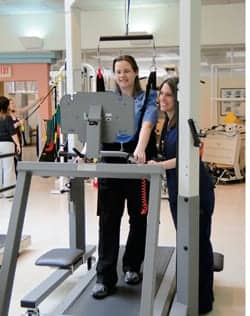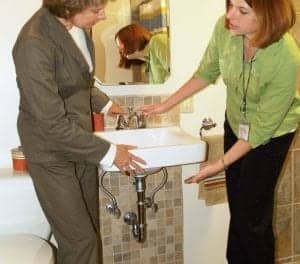
Jamie Dudek, PT, DPT, facilitates gait retraining utilizing a Partial Body Weight Supported Treadmill (PBWST).
As the therapy super-visors of the inpatient rehabilitation department at JFK Johnson Rehabilitation Institute, Edison, NJ, it is our responsibility to ensure that proper equipment is always available and remains in safe working condition. This can be challenging at times, as the patients admitted to the inpatient rehabilitation program have highly individualized needs for both therapy supplies and equipment. Compounding that challenge is the need to order supplies that will be issued to patients for their personal use (eg, Theraputty and hip abductor pillows) as well as supplies that will be used by therapists during treatment (eg, walkers and long-handled assistive devices). Ultimately, we are responsible for making recommendations, as well as purchasing supplies and equipment for use in the department. This responsibility makes it critical to research the best price and value for these items, via the Internet, catalogues, or direct contact with various vendors, especially since we are held accountable to capital and departmental budgets.
CREATING A WISH LIST
At various times throughout the year, we solicit feedback and input from the therapy staff related to the replacement of existing equipment, and the purchase of new equipment. Input from staff is received in a variety of ways, including group feedback during discipline-specific meetings and larger department staff meetings, or individually during supervision meetings. A “wish list” is also posted in the department for staff members to add their requests. Once equipment is purchased, the date of delivery is also added to the wish list, indicating that the requested equipment was indeed purchased. Once a year, feedback is solicited related to purchases of capital equipment. This input is requested several months ahead of the budget deadline, and staff members submit their requests after researching the vendor and cost. The staff member also includes a brief clinical rationale for the purchase. As the clinicians who actually use the equipment, the staff physical and occupational therapists’ input is extremely valuable. Not only does their input include them in the process clinically, by maintaining safe and clinically appropriate equipment, but it also exposes them to the administrative aspects of equipment ordering. Specifically, this includes prioritizing needs and fiscal accountability.
BUDGET STRATEGIES
When planning for annual purchases of both new equipment or replacement equipment, we strive to first make sure we have adequate funding in the department budget. Several months before the department director submits the proposed budget, we take inventory of current equipment and determine which pieces need to be replaced and in what quantity. We also try to anticipate any changes in our current patient mix or volume so we can be adequately prepared.
When purchasing noncapital budget items for the department (items that cost less than $2,000), we utilize many strategies to remain current with new products and technology, as well as obtain the best pricing. We frequently invite vendors and/or manufacturers to present their stock to keep all staff up to date on the latest equipment available, as well as to train new staff about commonly used materials. We develop close relationships and contacts with specific representatives from these companies and work directly with them to negotiate the best price for purchase. We also work closely with our materials management department to negotiate discounted prices or work with contracted providers. We often ask for samples or loaner equipment to trial in our department prior to purchasing in order to identify the most suitable items.
When we have made our decisions regarding the products we wish to purchase through the department budget, we order them through our electronic purchasing system. This system links our department with materials management, where the equipment is actually ordered, as well as with our receiving department. It allows us to be knowledgeable of where in the process the order is, including if it was ordered, on back order, or received.
Throughout the year, we must remain accountable to the department budget, which we monitor by viewing monthly budget reports. One strategy used to adhere to budget constraints is to decide whether to order the necessary items all at once or spread out the spending over a few months (ie, ordering three walkers each month for 4 months versus 12 walkers all in 1 month). Another strategy to reduce cost is to price comparison shop between vendors and durable medical equipment companies. We do this for specific specialized pieces of equipment (ie. wheelchairs, wheelchair cushions), as well as less specific items (walkers, transfer boards, positioning devices). We also, at times, ask vendors or the manufacturer for donations. The materials management department is also helpful in obtaining reduced pricing through contracted providers for less specific equipment.
We take great care with respect to clinical equipment to ensure needs are met for staff and patients. Some pieces of equipment, designed for single patient use, or other single pieces of equipment that are expensive, need to be stored in areas separate from where the majority of inpatient rehab equipment is kept. Secure closets are designated for housing these particular items and frequent inventories are taken to prevent these supplies from becoming exhausted or being misplaced. Additionally, supplies are available through the central supply department of the hospital, which houses therapy items utilized by multiple departments (eg, axillary crutches, hand splints, and knee immobilizers). We also collaborate with members of nontherapy departments who can help guide us in purchasing the best quality and value for technology (eg, respiratory therapy consulted for pulse oximeter brands and pricing).
All rehab personnel are responsible for notifying the supervisory staff when equipment needs to be restocked, and for removing damaged or unsafe equipment from use. When equipment is removed because it is unsafe, we enlist the help of the biomedical engineering or building services departments, to determine whether it can be repaired, or if it must be replaced. We also determine if a piece of equipment is still under warranty prior to repairing it through one of our departments.
KEEPING UP WITH TECHNOLOGY
Advances are continually made in the world of rehabilitation technology, and we are vigilant in efforts to remain abreast of equipment that is new or changing. We strive to maintain a state of the art facility to better serve the needs of our patients and promote safety and patient independence. However, such innovative technologies generally come with a large price tag. Capital budget items (those that cost more than $2,000) are considered for purchase at the facility level. Some items are purchased primarily for a single department (wheelchairs/cushions, etc), while other items are purchased for multiple department use. Requests for all items are collected annually by the management staff of each department after soliciting input from staff.
There are also specific interdisciplinary committees (eg, minimal lift/safe patient handling, advanced technology) that meet to help determine the need to purchase certain items. These committees make recommendations about new technology, replacement items, and staff/patient safety considerations. Committee members are representative of different disciplines (physical, occupational, speech therapies, nursing, physicians) as well as different departments throughout the JFK Health System (rehabilitation, nursing, occupational health, education and organizational development, risk management, etc). Representatives from selected vendors and medical technology companies then present the committee members and employees with in-services and hands-on trials, often during “equipment fairs” throughout the year. Such fairs are information-gathering sessions that enable the committee members and management to decide the next course of action relative to purchasing. Items that will be used facility-wide are recommended by these committees after staff level clinicians have trialed the equipment and given the “thumbs up.” After this exhaustive research and investigation for the best quality and value related to capital budget items (eg, electric lift and transfer systems, robotic technology, body-weight supported treadmill system, or tilt-in-space wheelchairs), a comprehensive written proposal is submitted to the department director and subsequently to the vice-president for approval. The final path for all capital equipment approval ends with the chief operating officer, and then the finance department.
Additionally, there are several pieces of capital equipment that are physically located in one particular rehabilitation department but shared among all departments within the Rehabilitation Institute. Some examples include a robotic upper extremity device, body-weight supported treadmill system, and highly sophisticated neuromuscular electrical stimulation devices. This enables the facility to own expensive advanced equipment but also save money by having departments share in their use. Departments work together by scheduling their time to reserve the equipment.
In summary, most requests for equipment purchases start with the staff who are using the equipment. Sometimes the requests are to replace worn or unsafe equipment, for patient supplies, or for new equipment. Next, the budget is reviewed to determine how much funding is available, and the requests are prioritized. As equipment is purchased and received, staff members are informed of the purchase, and the equipment is released for use. All equipment purchased that is expensed at less than $2,000 can be purchased directly by a supervisor, or the department director, who ultimately has accountability to keeping within the budget. Items costing more than $2,000 must be approved by additional levels of upper management, including the area vice-president, chief operating officer, and finance department depending on the type and cost of equipment.
Jamie R. Dudek, PT, DPT, is the Inpatient Rehabilitation Physical Therapy supervisor of JFK Johnson Rehabilitation Institute. She has been practicing for over 10 years and enjoys working with the neurological and amputee populations in the inpatient setting.
Lori A. Madden, MSOTR, is the Occupational Therapy supervisor for the inpatient rehabilitation department at the JFK Johnson Rehabilitation Institute. She has been employed by the Johnson Rehabilitation Institute for the past 8 years and enjoys working with adult rehab patients as well as mentoring the staff.
Christa Reineke, MA, PT, is director of the Inpatient Rehabilitation program, Day Rehabilitation program, and the Cardiac Rehabilitation program at the JFK Johnson Rehabilitation Institute. She has worked as a therapist and supervisor and also presented at national conferences, on both clinical and administrative topics. For more information, contact .




